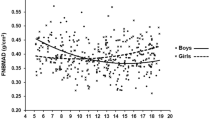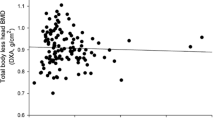Abstract
Summary
The aim of this study was to compare hip bone strength indices in obese, overweight, and normal-weight adolescent boys using hip structure analysis. After adjusting for weight, obese boys displayed lower intertrochanteric cross-sectional moment of inertia and femoral shaft cross-sectional moment of inertia and section modulus in comparison to normal-weight and overweight boys. This study suggests that in obese adolescent boys, femoral shaft bending strength is not adapted to the increased body weight.
Introduction
The influence of being obese or overweight on bone strength in adolescents remains controversial. The main aim of this study was to compare hip bone strength indices in obese, overweight, and normal-weight adolescent boys using hip structure analysis. The second aim of this study was to explore the influence of lean mass and fat mass on hip bone strength indices in the same population.
Methods
This study included 70 adolescent boys (25 obese, 25 normal weight, and 20 overweight). The three groups (obese, overweight, and normal weight) were matched for maturity (Tanner stage) and age. Body composition and bone mineral density (BMD) were assessed by dual-energy X-ray absorptiometry (DXA). To evaluate hip bone strength, DXA scans were analyzed at the femoral neck (FN), the intertochanteric (IT), and the femoral shaft (FS) by the Hip Structure Analysis (HSA) program. Cross-sectional area (CSA), an index of axial compression strength, section modulus (Z), an index of bending strength, and cross-sectional moment of inertia (CSMI), an index of structural rigidity were measured from bone mass profiles.
Results
Body weight, lean mass, fat mass and BMI were significantly higher in obese and overweight boys in comparison to normal-weight boys (P < 0.05). Total hip (TH) BMD and femoral neck (FN) BMD were significantly higher in obese and overweight boys in comparison to normal-weight boys (P < 0.05). After adjusting for age or maturation index, obese and overweight boys displayed significantly higher TH and FN BMD, CSA, CSMI, and Z of the three sites (FN, IT, and FS) in comparison to normal-weight boys (P < 0.05). However, after adjusting for weight, obese boys displayed significantly lower IT CSMI and FS CSMI and Z in comparison to normal-weight and overweight boys (P < 0.05).
Conclusions
This study suggests that in obese adolescent boys, intertrochanteric structural rigidity and femoral shaft structural rigidity and bending strength are not adapted to the increased body weight.

Similar content being viewed by others
References
Rizzoli R, Bonjour JP, Ferrari SL (2001) Osteoporosis, genetics and hormones. J Mol Endocrinol 26:79–94
Reid IR (2010) Fat and bone. Arch Biochem Biophys 503:20–27
El Hage R, Jacob C, Moussa E, Benhamou CL, Jaffré C (2009) Total body, lumbar spine and hip bone mineral density in overweight adolescent girls: decreased or increased? J Bone Miner Metab 27:629–633
Leonard MB, Shults J, Wilson BA, Tershakovec AM, Zemel BS (2004) Obesity during childhood and adolescence augments bone mass and bone dimensions. Am J Clin Nutr 80:514–523
Ellis KJ, Shypailo RJ, Wong WW, Abrams SA (2003) Bone mineral mass in overweight and obese children: diminished or enhanced? Acta Diabetol 40:S274–S277
De Schepper J, Van den Broeck M, Jonckheer M (1995) Study of lumbar spine bone mineral density in obese children. Acta Paediatr 84:313–315
Rocher E, Chappard C, Jaffré C, Benhamou CL, Courteix D (2008) Bone mineral density in prepubertal obese and control children: relation to body weight, lean mass, and fat mass. J Bone Miner Metab 26:73–78
Manzoni P, Brambilla P, Pietrobelli A, Beccaria L, Bianchessi A, Mora S, Chiumello G (1996) Influence of body composition on bone mineral content in children and adolescents. Am J Clin Nutr 64:603–607
Goulding A, Taylor RW, Jones IE, Manning PJ, Williams SM (2002) Spinal overload: a concern for obese children and adolescents? Osteoporos Int 13:835–840
Hasanoglu A, Bideci A, Cinaz P, Tumer L, Unal S (2000) Bone mineral density in childhood obesity. J Pediatr Endocrinol Metab 13:307–311
El Hage R, Moussa E, Jacob C (2010) Bone mineral content and density in obese, overweight and normal-weighted sedentary adolescent girls. J Adolesc Health 47:591–595
El Hage R, Jacob C, Moussa E, Groussard C, Pineau JC, Benhamou CL, Jaffré C (2009) Influence of the weight status on bone mineral content and bone mineral density in a group of Lebanese adolescent girls. Joint Bone Spine 76:680–684
El Hage R, Moussa E, Jacob C (2010) Femoral neck geometry in overweight and normal weight adolescent girls. J Bone Miner Metab 28:595–600
Ducher G, Bass S, Naughton GA, Eser P, Telford RD, Daly RM (2009) Overweight children have a greater proportion of fat mass relative to muscle mass in the upper limbs than in the lower limbs: implications for bone strength at the distal forearm. Am J Clin Nutr 90:1104–1111
Farr JN, Chen Z, Lisse JR, Lohman TG, Going SB (2010) Relationship of total body fat mass to weight-bearing bone volumetric density, geometry, and strength in young girls. Bone 46:977–984
Wetzsteon RJ, Petit MA, Macdonald HM, Hughes JM, Beck TJ, McKay HA (2008) Bone structure and volumetric BMD in overweight children: a longitudinal study. J Bone Miner Res 23:1946–1953
Greene DA, Naughton GA, Briody JN, Kemp A, Woodhead H, Corrigan L (2005) Bone strength index in adolescent girls: does physical activity make a difference? Br J Sports Med 39:622–627
Petit MA, Beck TJ, Shults J, Zemel BS, Foster BJ, Leonard MB (2005) Proximal femur bone geometry is appropriately adapted to lean mass in overweight children and adolescents. Bone 36:568–576
El Hage R, Courteix D, Benhamou CL, Jacob C, Jaffré C (2009) Relative importance of lean and fat mass on bone mineral density in a group of adolescent boys and girls. Eur J Appl Physiol 105:759–764
Fulton JP (1999) New guidelines for the prevention and treatment of osteoporosis. National Osteoporosis Foundation. Med Health RI 82:110–111
Beck TJ, Ruff CB, Warden KE, Scott WW Jr, Rao GU (1990) Predicting femoral neck strength from bone mineral data. A structural approach. Invest Radiol 25:6–18
Martin RB, Burr DB (1984) Non-invasive measurement of long bone cross-sectional moment of inertia by photon absorptiometry. J Biomech 3:195–201
Forwood MR, Bailey DA, Beck TJ, Mirwald RL, Baxter-Jones AD, Uusi-Rasi K (2004) Sexual dimorphism of the femoral neck during the adolescent growth spurt: a structural analysis. Bone 35:973–981
Janz KF, Gilmore JM, Levy SM, Letuchy EM, Burns TL, Beck TJ (2007) Physical activity and femoral neck bone strength during childhood: the Iowa Bone Development Study. Bone 41:216–222
McKay HA, MacLean L, Petit M, Mackelvie-O’Brien K, Janssen P, Beck T, Khan KM (2005) “Bounce at the Bell”: a novel program of short bouts of exercise improves proximal femur bone mass in early pubertal children. Br J Sports Med 39:521–526
Cole TJ, Bellizzi MC, Flegal KM et al (2000) Establishing a standard definition for child overweight and obesity worldwide: International survey. BMJ 320:1–6
El Hage R, Jacob C, Moussa E, Youssef H, Groussard C, Pineau JC, Jaffré C (2008) Leptin, insulin, IGF-1 and bone mass in a group of sedentary adolescent girls. J Med Liban 56:220–225
El Hage R, Moussa E, El Hage Z, Jacob C (2011) Birth weight a negative determinant of whole body bone mineral apparent density in a group of adolescent boys. J Clin Densitom 14:63–67
Beck T, Looker A, Ruff C, Sievanen H, Wahner H (2000) Structural trends in the aging femoral neck and proximal shaft: analysis of the Third National Health and Nutrition Examination Survey (NHANES) dual-energy X-ray absorptiometry data. J Bone Miner Res 15:2297–2304
Yates LB, Karasik D, Beck TJ, Cupples LA, Kiel DP (2007) Hip structural geometry in old-old age: similarities and differences between men and women. Bone 41:722–732
Crabtree N, Lunt M, Holt G, Kröger H, Burger H, Grazio S et al (2000) Hip geometry, bone mineral distribution, and bone strength in European men and women: the EPOS study. Bone 27:151–159
Khoo BC, Beck TJ, Qiao QH, Parakh P, Semanick L, Prince RL, Singer KP, Price RI (2005) In vivo short-term precision of hip structure analysis variables in comparison with bone mineral density using paired dual-energy X-ray absorptiometry scans from multi-center clinical trials. Bone 37:112–121
Duke PM, Litt IF, Gross RT (1980) Adolescents’ self assessment of sexual maturation. Pediatrics 66:918–920
Fardellone P, Sebert JL, Bouraga M, Bonidan O, Leclercq G, Doutrellot C, Bellony R (1991) Evaluation of the calcium content of diet by frequential self-questionnaire. Rev Rhum Mal Osteoartic 58:99–103
El Hage R, Jacob C, Moussa E, Jaffré C, Benhamou CL (2009) Daily calcium intake and body mass index in a group of Lebanese adolescents. J Med Liban 57:253–257
Deheeger M, Rolland-Cachera MF, Fontvieille AM (1997) Physical activity and body composition in 10 year old French children: linkages with nutritional intake? Int J Obes Relat Metab Disord 21:372–379
Artz E, Haqq A, Freemark M (2005) Hormonal and metabolic consequences of childhood obesity. Endocrinol Metab Clin North Am 34:643–658
Frost HM (2003) Bone’s mechanostat: a 2003 update. Anat Rec 275:1081–1101
Rauch F, Bailey D, Baxter-Jones A, Mirwald R, Faulkner R (2004) The muscle–bone unit during the pubertal growth spurt. Bone 34:771–775
Płudowski P, Lebiedowski M, Olszaniecka M, Marowska J, Matusik H, Lorenc RS (2006) Idiopathic juvenile osteoporosis–an analysis of the muscle-bone relationship. Osteoporos Int 17:1681–1690
Petit MA, Beck TJ, Kontulainen SA (2005) Examining the developing bone: what do we measure and how do we do it? J Musculoskelet Neuronal Interact 5:213–224
Travison TG, Araujo AB, Esche GR, Beck TJ, McKinlay JB (2008) Lean mass and not fat mass is associated with male proximal femur strength. J Bone Miner Res 23:189–198
Bonjour JP, Chevalley T, Rizzoli R, Ferrari S (2007) Gene-environment interactions in the skeletal response to nutrition and exercise during growth. Med Sport Sci 51:64–80
Bréban S, Chappard C, Jaffre C, Khacef F, Briot K, Benhamou CL (2011) Positive influence of long-lasting and intensive weight-bearing physical activity on hip structure of young adults. J Clin Densitom 14:129–137
Petit MA, Beck TJ, Lin HM, Bentley C, Legro RS, Lloyd T (2004) Femoral bone structural geometry adapts to mechanical loading and is influenced by sex steroids: the Penn State Young Women’s Health Study. Bone 35:750–759
Petit MA, Beck TJ, Hughes JM, Lin HM, Bentley C, Lloyd T (2008) Proximal femur mechanical adaptation to weight gain in late adolescence: a six-year longitudinal study. J Bone Miner Res 23:180–188
Ferry B, Duclos M, Burt L, Therre P, Le Gall F, Jaffré C, Courteix D (2011) Bone geometry and strength adaptations to physical constraints inherent in different sports: comparison between elite female soccer players and swimmers. J Bone Miner Metab 29:342–351
Raman A, Lustig RH, Fitch M, Fleming SE (2009) Accuracy of self-assessed tanner staging against hormonal assessment of sexual maturation in overweight African-American children. J Pediatr Endocrinol Metab 22:609–622
Schaefer EJ, Augustin JL, Schaefer MM, Rasmussen H, Ordovas JM, Dallal GE, Dwyer JT (2000) Lack of efficacy of a food-frequency questionnaire in assessing dietary macronutrient intakes in subjects consuming diets of known composition. Am J Clin Nutr 71:746–751
Bonnick SL (2007) HSA: beyond BMD with DXA. Bone (NY) 41:S9–S12
Beck TJ (2003) Measuring the structural strength of bones with dual-energy X-ray absorptiometry: principles, technical limitations, and future possibilities. Osteoporos Int 14:S81–S88
Gordon CM, Bachrach LK, Carpenter TO et al (2008) Dual energy X-ray absorptiometry interpretation and reporting in children and adolescents: the 2007 ISCD Pediatric Official Positions. J Clin Densitom 11:43–58
Beck TJ, Petit MA, Wu G, LeBoff MS, Cauley JA, Chen Z (2009) Does obesity really make the femur stronger? BMD, geometry, and fracture incidence in the women’s health initiative-observational study. J Bone Miner Res 24:1369–1379
Beck TJ, Kohlmeier LA, Petit MA et al (2011) Confounders in the association between exercise and femur bone in postmenopausal women. Med Sci Sports Exerc 43:80–89
Acknowledgments
This study was supported by a grant from the research council of the University of Balamand, Lebanon.
Conflicts of interest
None.
Author information
Authors and Affiliations
Corresponding author
Rights and permissions
About this article
Cite this article
El Hage, R. Geometric indices of hip bone strength in obese, overweight, and normal-weight adolescent boys. Osteoporos Int 23, 1593–1600 (2012). https://doi.org/10.1007/s00198-011-1754-3
Received:
Accepted:
Published:
Issue Date:
DOI: https://doi.org/10.1007/s00198-011-1754-3




